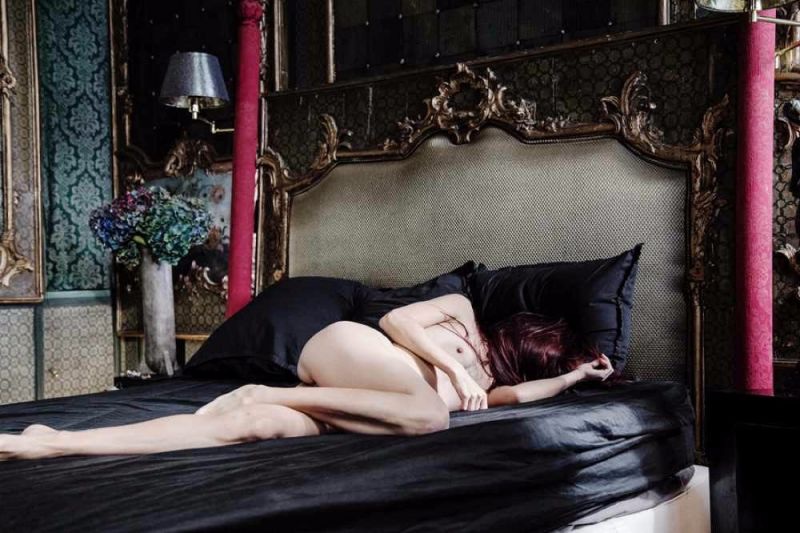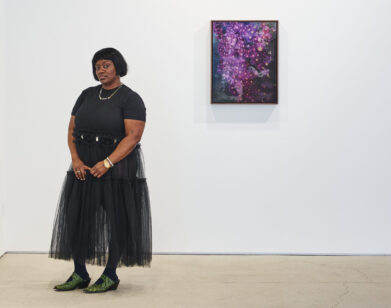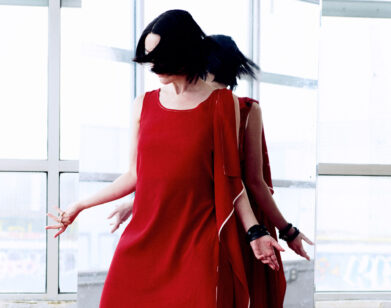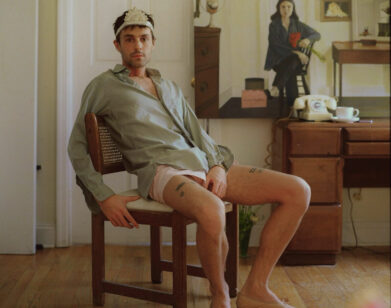Scarlett Rouge and Saulo Madrid’s Modern Mythology
At the Artissima art fair in Torino, Italy, this weekend, interdisciplinary artists Scarlett Rouge and Saulo Madrid will present their film and installation Beyond the Walls of Eden for the first time. The 12-minute film component, many years in the making, features Rouge and her mother Michèle Lamy in a lush, Lynchian fairy tale set in a gilded apartment in Paris—an apartment just across the Place du Palais Bourbon from the home Lamy shares with Rick Owens, and where they commissioned a monumental fresco from Rouge. Artissima is a bit of a hometown affair for Rouge who, though she grew up in Los Angeles starring in her father’s experimental films, and graduated from CalArts in 2002, has lived and worked primarily in Torino for the last few years. The curator and filmmaker Madrid is no less peripatetic, having graduated from Harvard (2004), Concordia University (2009), and the Sorbonne (2010) before working in magazines and museums. In advance of their big premiere, I corresponded with the artists to talk about inspirations and the world they’ve built.
CHRIS WALLACE: Here we go, Scarlett, overthinking movies again. But let’s start at the beginning: what was the impetus for this?
SCARLETT ROUGE: Like everything, it is difficult to pinpoint exactly the thing that began it all. And as there are two authors on the project, our impetuses may differ. For me, I was living in Paris, and housed by Michèle in this fabulously decrepit apartment formerly owned by the socialite Dodie Rosekrans, and designed by the brilliant designer Tony Duquette. When Saulo joined me, he was mourning the passing of his mother. This seemed to be a theme at the time of my life, as I had recently been nurturing several friends who had lost their mothers. All of which was making me face the eventuality of my own mother’s death—and to acknowledge my need to accept our differences, and fully enjoy who she is. At the time, Saulo was creating content for this artsy French mag called Exhibition, and they came to me with the simple idea of shooting me walking around our ghostly apartment nude, save for white powder on my skin. Next thing I knew, Saulo met someone from a production company (Cinq Etoiles Productions) at a party; they loved the idea, they saw the apartment, fell more in love, happened to be partners with my advertising producer cousin in China—Michèle’s nephew… They had no idea of the Pandora’s box they were opening. Which brings me back to my relationship with Saulo. For long hours we spoke, laughed, and cried, sitting at the worktable that became the stage for the two dinner scenes of the film. We spoke of our mothers, we spoke of the “great expectations” we felt unprepared for but felt pressured to measure up to by our mothers’ excellence. And these moments were the propelling force of the narrative and world of Beyond the Walls of Eden.
WALLACE: There is a bit of … is it Cinderella? The princess, the elder figure, the castle! I’ve always appreciated the way you have talked about your relationship with Michèle, and the way you’ve plucked at it a bit in your work. It’s interesting to see you—or, the princess-y character—sort of displacing her character here.
ROUGE: The whole second tableau of the film is about the oppression by the mother—who in fairytales is often the stepmother. We utilized the black ink to covey the idea of oppression and, funnily enough, it was only after I showed an edit to one of Michèle’s friends, Annabelle, a psychoanalyst and art critic, that we truly understood how poignant this symbol was. She pointed out that Michèle’s black painted fingers represented her way of obscuring reality and that she was like an octopus who throws ink in your face as a means to control the situation. I ended up creating urns based off the shape of an octopus body, sans les tentacles, for the exhibition. As far as plucking or teasing my relationship with Michèle, this is probably the most comprehensive and cathartic artwork I have every made.
SAULO MADRID: Humans seem to be able to convey some more somber thoughts or fears through fairy tales and more allegorical representations. In Alice in Wonderland it is leaving quotidian life to find one’s inter-subjectivity. And the costumes and the surrealism in Beyond the Walls of Eden are charged with the fear of mortality and the celebration of becoming whole.
WALLACE: The dreamy voiceover is a kind of Michèle staple at this point, and makes her imprimatur extra evident on this. You seem to be welcoming that: this is a Michèle Lamy joint. Scarlett, are you guys collaborators at this point, or co-conspirators? There is clearly tension in the narrative, but it feels more like a duet.
ROUGE: At the beginning of the film we wanted to show how larger than life Michèle is. The first tableau, or poem scene, refers to how this woman can take over any room, even our empty living room, and make it her platform to expose her iconic image, as well as turning any available furniture into her pulpit. Michèle and I are still not the best partners in crime when it comes to work; she loves the chaos and I love a considerate order. We are more of an emotion system than co-workers, though our complicity has strengthened.
MADRID: The Langston Hughes poem [Red Roses, which Michèle reads in the opening scene] also reveals a human dichotomy—the power of the poem and the fragility of human beings. The reading is on this pedestal, surrounded by gold and in this majestic dress as a queen, but the vulnerability with which she delivers the poem points to a much more complex woman then the icon. Like everyone else, I have found Michèle an incredible source of fascination. I worked on a piece on globalization in which she spoke about the position of women today. She did it brilliantly, yet in her own way. In Beyond the Walls of Eden, she knew exactly what she did not want, and was incredibly aware of what did not work. It was so easy as she has been in front of the camera. You do not want to annoy her though, and it feels you have to be precise.
WALLACE: I always talk with Rick and Michèle about this world that they have created that is outside of the rest of the world, so it’s especially interesting to see something that is set within that world that refracts it or reframes it… Maybe even appropriates it? This is most certainly a world through your prism and that of Saulo’s. I suppose it is inevitable that you would see their world and show it differently than they would.
ROUGE: Yes, I am always using the symbols of my world to burst my own bubble. We are definitely using and re-appropriating their images to describe a world that is completely our own. I suppose you could say we are taking advantage of their strongly shaped images to express our vision. Rain Li, a director and cinematographer from China, who has worked with Wong Kar-wai and Christopher Doyle, acted as onset technical director as well as director of photography. I met Simon Whetham, a sound artist who makes amazing soundscapes by recording cellphone batteries or snow melting, while doing an artist residency in Iceland. For the installation at the Casa del Pingone in Torino… it is about moving beyond the layers of consciousness and a journey into the unconscious, from material to the void. We begin with my sculptures and then we start to get more ephemeral with a hallway of pools of lights and sounds. We end with the film projected inside a black box—here we are really getting into the mind and revealing the deep intimate images of the unconscious.
MADRID: We had so many incredible objects—the Tony Duquette orientalist-baroque space; and the minimal objects of Rick and Michèle—and access to incredible costumes. The idea was to create paintings, each state of consciousness. The first room was meant to convey a sense of grandiosity with Michèle wearing the CDG dress and looking extremely regal, surrounded by gold. The nightmare scene was meant to be like a rococo painting where Scarlett was in this dream world… The bath scene is one of my favorites. Scarlett’s makeup is by Pablo Rodriguez who Michèle always works with, and it helped create this incredible out of world look—I wanted her to be this being that was being born.
WALLACE: The symbolism of what we would have traditionally called the feminine (springtime, fertility, warmth) is very prevalent here. Are those sorts of mythic symbols still potent? Are we in need of new myths about gender, about family?
MADRID: I think the traditional sense of family for most of the Western world has changed for political, socio-economic reasons—and simply because of globalization. There is absolutely a paradigmatic shift.
ROUGE: I completely believe that our old cultural myths have died. We all know it. As intellectual and scientifically aware people, we can no longer relate to the old stories that happened within in the “Garden of Eden”… so we must go “Beyond the Walls of Eden” and create a new mythology that speaks to us and which we can reconcile with our contemporary reality, while not ignoring the eternal world we all live in.
The idea of myths and creating new myths is very dear to me, it’s a passion of mine, and is the crux of all my work. I’ve always been interested in mysticism, Jungian psychology, and the power of symbols, whether they be magical, religious, or even advertising. For me, the artist is a form of modern day shaman. The artist’s role is to use their own spiritual or mystical journey and bring back the treasure from the deep dark sea within, to find the symbolic or allegoric was to communicate their findings to the world. It is his/her purpose is to heal themselves and by proxy the public. So, yes, we need to create new myths about gender and family, and, hey, if Disney can do it with Brave and Frozen, art had better get a move on it or it is perilously on the verge of being socially irrelevant to anyone outside of the art world.
FOR MORE ON THE ARTISSIMA ART FAIR, CLICK HERE.







